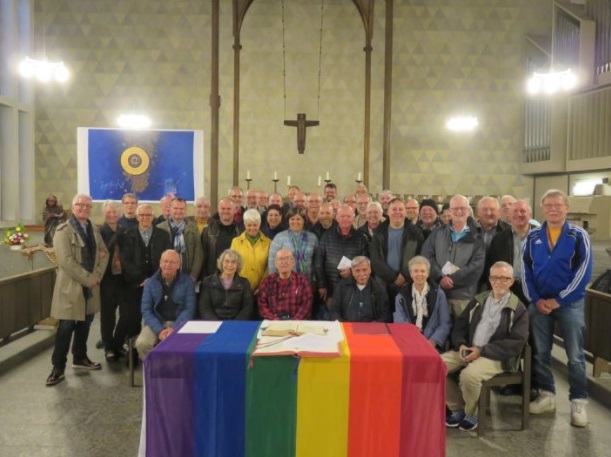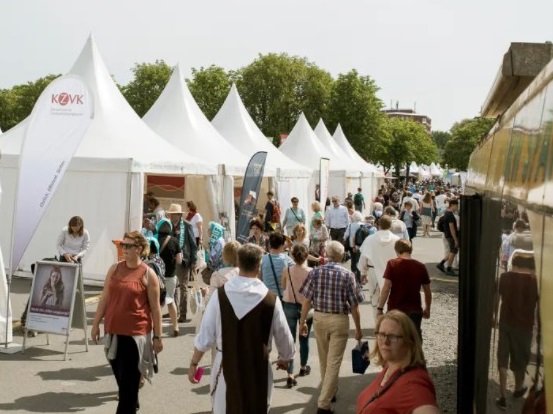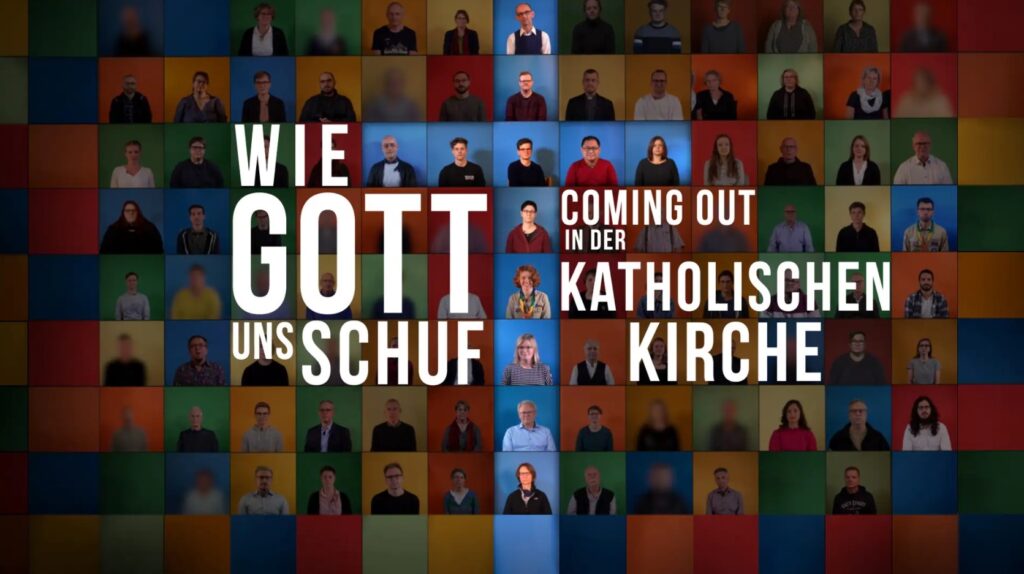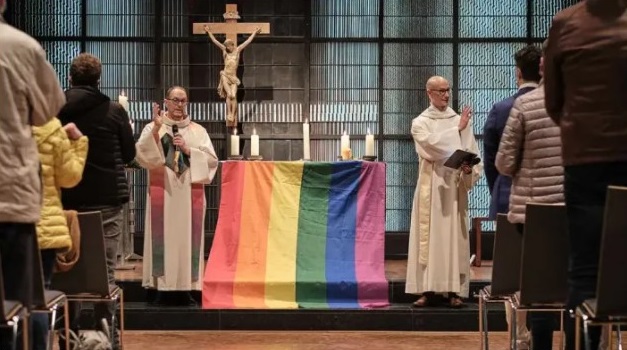FRANKFURT (GERMANY)
New Ways Ministry [Mount Rainier MD]
March 21, 2022
By Dr. Michael Brinkschröder
Over the past few years, members of the LGBTQ Catholic community around the globe have been watching how Germany’s church leaders, organizations, and laity are leading the way on progressive measures for LGBTQ equality. Inevitably, the question arises: “How is that happening there when in other places we still struggle?”
Bondings 2.0 editors asked Dr. Michael Brinkschröder, one of the leaders of the Catholic LGBTQ movement in Germany, to provide an analysis of what has been happening in the church in that nation that has allowed it to move so far forward on LGBTQ issues. Dr. Brinkschröder, a theologian and sociologist, is a member of #OutInChurch and co-chair of the German Catholic LGBT+ Committee. The following is his response.
Introduction: Waves of Solidarity and Support
In January of this year, 125 LGBTIQ church workers in Germany came out by issuing a statement “#OutInChurch” and by having a documentary “Wie Gott uns schuf” (How God Created Us) broadcast on German television.
The Catholic Church in Germany responded strongly with waves of solidarity and support. Over 90% of the delegates to the General Assembly of the Synodal Path, a national German Catholic consultation process, voted to delete references to the marital status of divorced-remarried or same-sex couples, or gender identity as Catholic morality criteria in the church’s labor law. Six bishops offered assurances that nobody in pastoral or educational ministry would lose their jobs because of same-sex marriage or a gender transition. Eleven diocesan Vicars General signed a letter demanding a change in the church’s labor law to protect LGBTIQ employees. More than 118,000 people signed a petition in support of the seven core demands of the #OutInChurch movement, which included ending discriminatory practices, apologizing for the institutional history of harm related to LGBTIQ+ people, and moving towards a culture of diversity. These signatures were handed over to Bishop Georg Bätzing, the chair of the German Bishops’ Conference (DBK), and two other bishops from the conference’s Pastoral Committee. Forty Catholic lay associations published a statement of solidarity with #OutInChurch.
This outpouring shows an unprecedented interest among heterosexual and cisgender ministers to understand better how they could become more LGBTIQ-inclusive in their pastoral work.
Given this unexpected success of our campaign, the questions arise: Why did this happen in the Roman Catholic Church (RCC) in Germany? What were the enabling conditions?
Four factors played a role: 1) long lasting social structures of the church; 2) the prevailing theological conversation; 3) steady LGBTIQ+ activism in the last decade; 4) the momentum provided by a felicitous confluence of events
1) Social Structures in Church and Society
Since the 19th century the Catholic Church in Germany has strong associations of laity with democratic structures. All lay Catholics are represented by the Central Committee of German Catholics (ZdK), an official body of the church institution. In recent years, three large lay associations—the Federation of Catholic Youth Organizations, the Catholic Women’s Community, the Catholic German Women’s League—have been driving forces toward a progressive stance on LGBTIQ+ issues. A crucial step happened when the whole ZdK endorsed demands of these three groups to implement liturgical blessings for same-sex couples.
If we look at the other side of the laity-clergy divide, we see that the bishops have dramatically lost authority since numerous cases of clerical sexual abuse and their cover-ups became public. As a result, the bishops had no alternative to gain credibility unless they initiated the Synodal Path together with the ZdK.
A second factor in the social structure of the RCC in Germany is the large number of lay ministers with high academic qualifications. Due to the shrinking number of priests, these lay people are working in all kinds of leadership positions below the rank of a bishop, including the de facto leadership of parishes. This situation has helped to reduce the impact of structural homophobia connected to seminary education.
When it comes to LGBTIQ+ issues, German society is relatively homogeneous and has slowly, but without ruptures, moved towards legal equality and social inclusion. When the marriage equality law came into force in 2017, the majority of Protestant regional church bodies had already implemented equality in their marriage rites. Some of the more open-minded Catholic bishops perceived the marriage equality law as a wake-up call, stimulating an intense discussion about liturgical blessings for same-sex couples as an appropriate response from the Catholic Church.

2) Theological Discourse
The theological landscape in German-speaking countries is dominated by liberal methodologies. For example, historical-critical methods are standard in exegetical and dogmatic matters. Additionally, moral theology and social ethics have distanced themselves from natural law approaches and have embraced a universal human rights and dignity approach instead. Moreover, the Second Vatican Council is the unchallenged basis of systematic and pastoral theology. One dominant school of thought grounds their theology in the Pastoral Constitution Gaudium et spes with its pastoral and social-scientific method of “see-judge-act”. This approach enables them to value experience, the needs of people, and to find in these sources the “signs of the times”.
Gay, lesbian-feminist or queer theologies have remained marginal in German academic theology. While the level of productivity in these areas can’t be compared to the Anglophone world, these methodologies have been accessible since the 1990s through the Werkstatt Schwule Theologie, the journal of the Study Group of Gay Theology.
Two other crucial developments have occurred in the last two decades. While opposition to new ideas about gender became the dominant theological perspective of Catholic bishops’ conferences in many countries all over the world, only a very few German bishops joined this anti-gender campaign. Moreover, many academic theologians and women’s associations rejected the gender binary rhetoric promoted by the Pontifical Council for the Family since 2003. These theologians produced devastating critical arguments exposing the ideological character of the Council’s discourse and defending the use of gender as a fruitful theological category. Even the Pastoral Committee of the German Bishops’ Conference responded through a leaflet that presented gender non-conforming saints together with affirming explanations about sexual orientation and intersex conditions.
Another theological development was the way the clergy sexual abuse crisis was interpreted. While in many countries blaming gay priests got the upper hand, in Germany this view was rejected in favor of understanding how structural causes, such as the silencing of (homo-)sexuality during the seminary formation and the negative effects of obligatory celibacy, played a role.

3) Steady & United: Catholic LGBTIQ+ Church Politics
In the 1990s and 2000s, a number of Catholic LGBTIQ groups were formed in Germany: Homosexuals and Church, the Network of Catholic Lesbians, the Lesbian and Gay Service Communities, and Catholic Groups of Gay Priests. At first, these organizations existed primarily to support their members through more or less secret meetings. But in 2011, a common platform for these groups to discuss Catholic church politics was established: The Catholic LGBT+ Committee. This small group of activists developed a coherent long-term strategy.
We started with well-prepared dialogue meetings with a number of open-minded bishops. Then we grew by networking with theologians who worked in the fields of gender justice. We could also use the “Katholikentag” (Catholic Day), a national bi-annual church gathering, to discuss our issues during side events. These discussions were more and more accepted by the official program.
From 2015 to 2018, “Catholics for LGBT Equality,” a funded project, enabled us to take the next steps towards two more specific goals:
- We promoted the issue of liturgical blessing ceremonies for same-sex couples in three ways: a) through a major conference in Hamburg; b) through the collection of clandestine liturgical formulas; c) through a postcard campaign. When the Synodal Path began to take shape in 2019, the issue of blessing liturgies for couples was adopted into the agenda of its one of its subcommittees, the Forum on Partnership and Sexual Ethics.
- We worked (and continue to work) to increase the number of dioceses with official programs for LGBTI ministry. Our grassroots organizations established a close and trustful working relationship with the conference of those ministers. This was possible because no bishop had required sexual abstinence of LGBTI people as the pre-condition of this pastoral work.
Two years ago, the Catholic LGBT+ Committee and the Conference on LGBTI+ Ministry started to work on a common agenda to deepen LGBTI* pastoral work in four specific areas. We have built mixed teams on: 1) open and welcoming parishes; 2) development of an LGBTI+ curriculum for the formation of pastoral ministers; 3) knowledge and skills for pastoral ministry with trans and intersex people; and 4) changes to the labor law of the church.

4) The Momentum
A movement needs momentum to get off the ground. In the case of #OutInChurch, several events and activities created good opportunities. First of all, the Synodal Path has enabled intense and constructive conversations between bishops and lay people on issues such as celibacy, women’s ordination as deacons, division of power and sexual ethics. It has become clear that the reformers in the Synodal Path may gain the necessary 2/3 majority on the votes for most of these reform issues, including the 2/3 majority among the bishops.
Another inspirational driver for this momentum has been the new Catholic women’s movement Maria 2.0 (Mary 2.0), an activist initiative that keeps the pressure on bishops to make changes to achieve equal rights for women in church but also justice for survivors of sexual abuse.
The primary mover for #OutInChurch has been Jens Ehebrecht-Zumsande, a gay lay minister from Hamburg. He was inspired to start the ball rolling for this movement when 185 actors came out collectively under the headline “#ActOut” in the magazine Süddeutsche Zeitung, the most important newspaper in Germany, in February 2021. He believed that such a collective coming out was possible in the Catholic Church, too. He mobilized his network, contacted all existing Catholic LGBTIQ+ groups, and organized the first online-meeting just a few weeks later with over 90 participants.
The first meeting of this group happened just when the Vatican’s Congregation for the Doctrine of the Faith (CDF) published its ban on blessing same-sex couples. Two priests from this new network launched a signature campaign,“#mehrSegen” (more blessings), and over 2,600 ministers declared their willingness to continue to bless same-sex couples. A few weeks later in May, the hashtag-campaign “#Liebegewinnt” (love wins) called for public blessing liturgies for all couples. These ceremonies were celebrated in 111 churches and received incredible media attention. Even though the CDF and some bishops tried to silence a few of the responsible ministers, it became clear, that the CDF had lost its control over us.

Conclusion: For a Church without Fear
The first online meeting of #OutInChurch was an amazing moment for me. I was surprised to see that it was not just focused on gay priests, but also on lesbian and trans ministers, on queer teachers of religious education living in rainbow families, of non-binary students of theology, on lesbian professors of theology, on gay musicians, and on so many theologians who could not find work in church or had quit their jobs because of their identities. Such a broad diversity of Catholic LGBTIQ+ people!
At the first meeting, some kept their cameras off and used pseudonyms, some just used their initials, but many had already dared to be visible in this context. We decided not to rush with our coming-out, but to take our time to prepare everything well. Over the next year, we discussed our campaign’s name, the wording of our manifesto and core demands, and we chose Germany’s First TV Channel as our media partner. And we also grew in numbers and in courage.
And in the end, we made it! We made our contribution for a church without fear.
